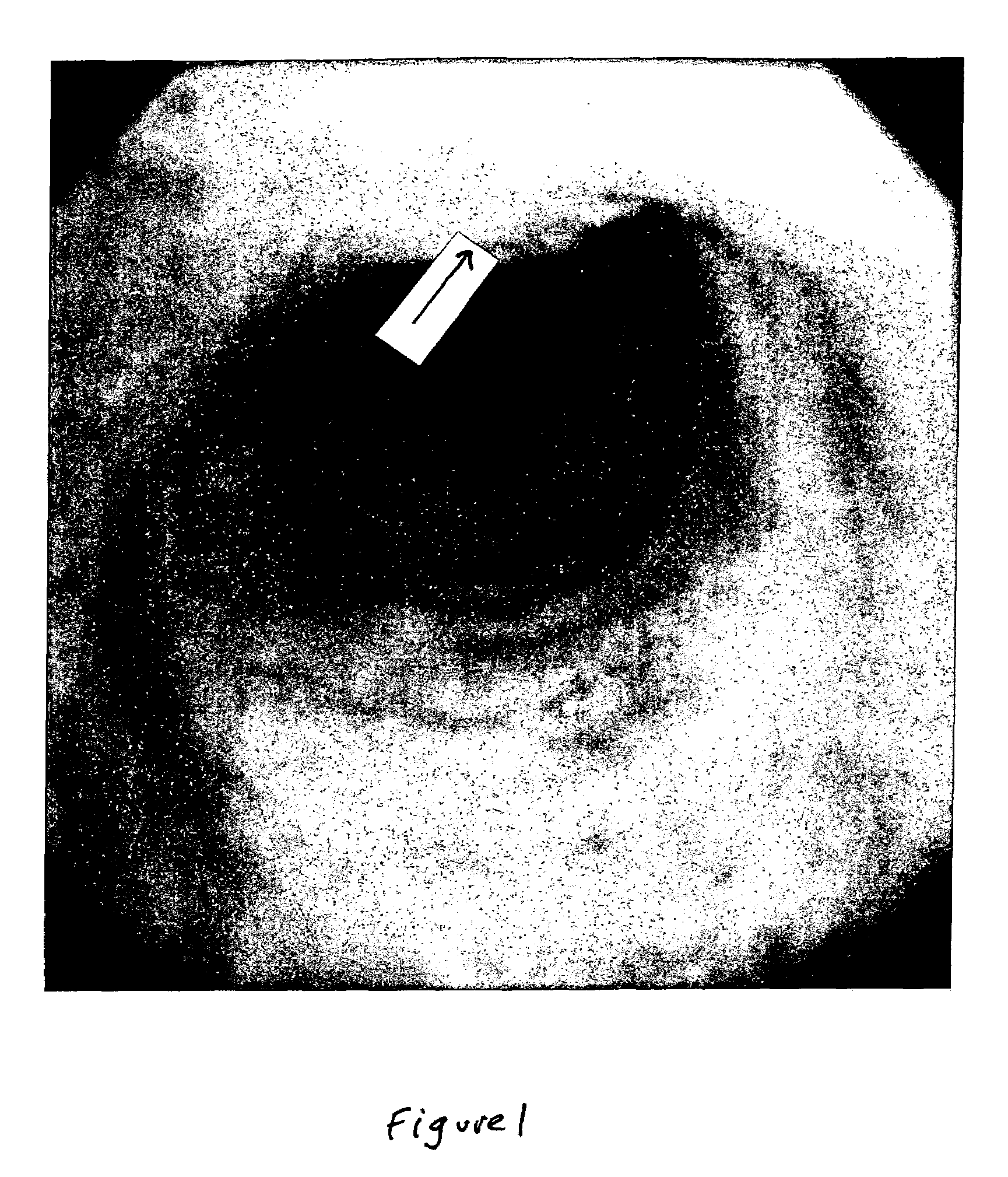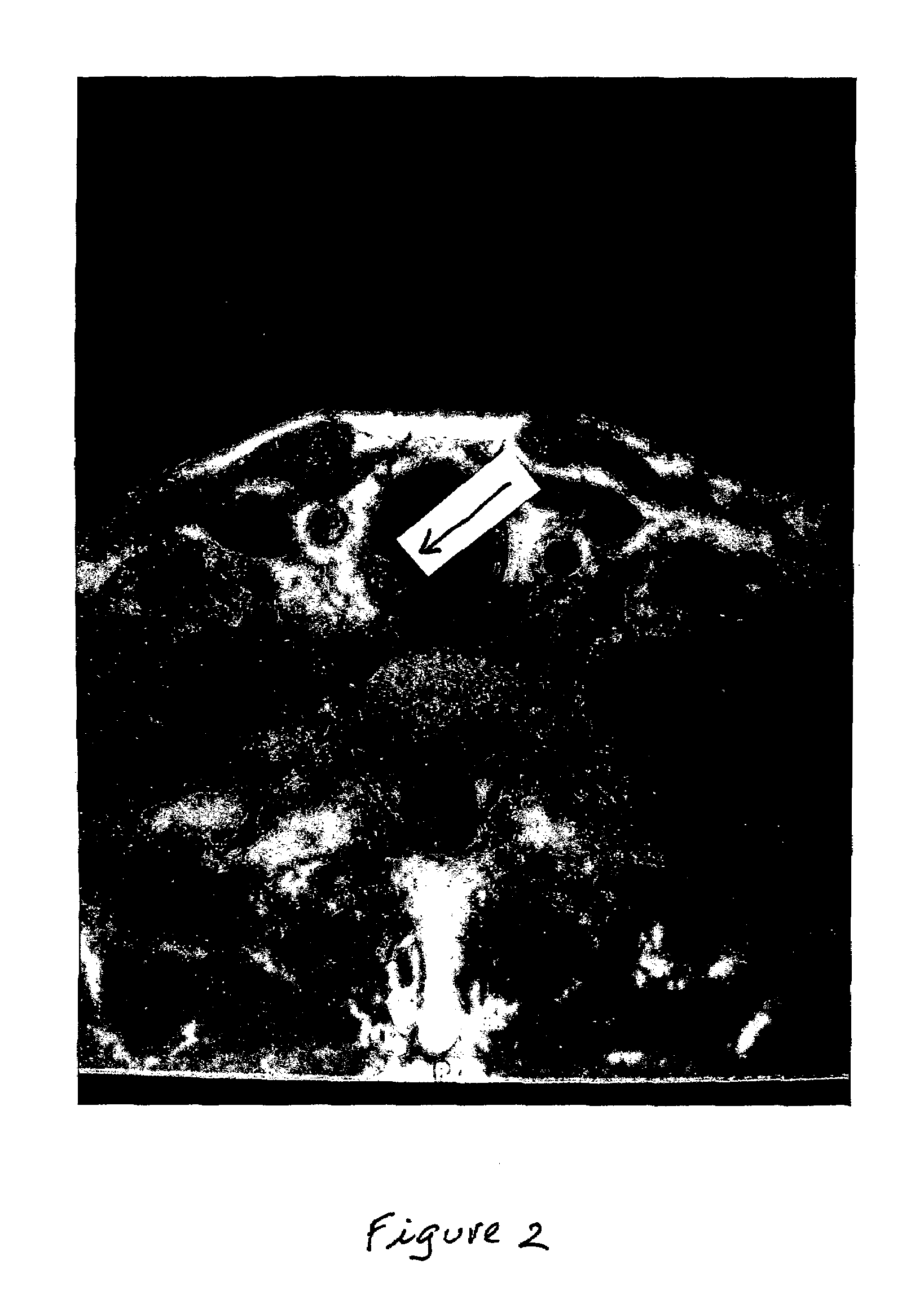Diagnosis and treatment of human dormancy-related sequellae
a technology of human dormancy and sequelae, applied in the field of human dormancy-related sequelae diagnosis and treatment, to achieve the effect of effective treatment, reducing symptoms, and reducing the progression of cancer
- Summary
- Abstract
- Description
- Claims
- Application Information
AI Technical Summary
Benefits of technology
Problems solved by technology
Method used
Image
Examples
example 1
Case Report: Antibiotics Eliminate Adenoid Cystic Carcinoma
[0116]A 41-year old male non-smoker developed gradually worsening dyspnea most noticeable while exercising in July 2000. Pulmonary Function Testing (PFT) revealed an abnormal flow volume loop consistent with airway obstruction. Laryngoscopic examination confirmed the presence of a sizable mass 1 cm below the vocal cords and CT scan showed greater than 80% obstruction of the airway Referral to an ENT physician was obtained and excisional biopsy was performed. Pathological examination confirmed the presence of Adenoid Cystic Carcinoma (ACC) with cribiform diploid cells (will use precise wording when report is available). The Tumor Board reviewed the case and laryngectomy was considered but not recommended at that time because the tumor margins extended beyond the trachea into the paratracheal fat making surgical cure unlikely. This malignant tumor typically travels along nerve sheaths, such as the recurrent laryngeal nerve, to...
example 2
Treatment of Colon Cancer
[0131]A 55-year old male was diagnosed with metastatic stage 4-colon cancer in November of 2004. The patient reported having had walking pneumonia in 1992 and had a positive Cpn IgG of 1:64. The patient underwent tumor debulking and re-anastimoses of the colon following surgery in November immediately following diagnosis. His carcinoembryonic antigen (“CEA”) level was 289 (Dec. 2, 2004), 568.4 (Dec. 21, 2004), and antibiotic therapy for Cpn was initiated on Dec. 20, 2004 with Amoxicillin. Ketek 400 mg 1 QD was initiated on Dec. 25, 2004 with Flagyl (metronidazole) 500 mg BID. He reported an immediate decrease in his abdominal pain and resolution of cervical lymphadenopathy. Abdominal distention was decreased. The patient stopped Flagyl for 24 hours and noticed a worsening of abdominal pain. CEA level was 888.6 (Jan. 7, 2005), and the antibiotic dose of Flagyl was adjusted to 500 mg 3 QD. The CEA increased to 1260 (Jan. 14, 2005) and the regimen was increased...
example 3
Treatment of Pancreatic Cancer
[0133]A 48 year old female from diagnosed with stage 4-metastatic pancreatic cancer on Sep. 18, 2004 presented for evaluation Dec. 29, 2004 looking cachexic. Chemotherapy with zoloda had failed. Ascites had developed and paracentesis was performed 3 days prior to our first visit. She was having difficulty breathing and eating due to abdominal distention from ascites. Her pre-treatment rT3 was severely elevated at 0.72 (0.19-0.46). Treatment with Amoxicillin 500 mg 1 QD, Ketek 500 mg 1 QD, and Flagyl 500 mg 1-2 QD was initiated. The patient reported less abdominal pain and less ascitic fluid on Jan. 4, 2005 and was tolerating the above protocol. Her lab results from Jan. 5, 2005 showed improvement in 10 variables as compared with Dec. 27, 2004:[0134]Sodium increased from 132 to 136,[0135]Potasium increased from 4.4 to 4.7,[0136]Chloride increased from 97 to 98,[0137]Total protein increased from 5.3 to 5.7,[0138]Albumin increased from 1.9 to 2.7,[0139]AST...
PUM
| Property | Measurement | Unit |
|---|---|---|
| Body temperature | aaaaa | aaaaa |
| weight | aaaaa | aaaaa |
| weight | aaaaa | aaaaa |
Abstract
Description
Claims
Application Information
 Login to View More
Login to View More - R&D
- Intellectual Property
- Life Sciences
- Materials
- Tech Scout
- Unparalleled Data Quality
- Higher Quality Content
- 60% Fewer Hallucinations
Browse by: Latest US Patents, China's latest patents, Technical Efficacy Thesaurus, Application Domain, Technology Topic, Popular Technical Reports.
© 2025 PatSnap. All rights reserved.Legal|Privacy policy|Modern Slavery Act Transparency Statement|Sitemap|About US| Contact US: help@patsnap.com



